The Last Tinker: City of Colors Review
Back in the PS2/Xbox/GameCube era, 3D platformers were all the rage. Seemingly every developer wanted to capitalise on the success of Super Mario 64 and put their own stamp on the genre using the new technology. It was the source of many poor imitations with little imagination, but in the right hands the genre also brought some of the best games of the generation. Titles such as Jak and Daxter, Ratchet and Clank, Sly Cooper, and Psychonauts proved that with the right combination of fun, fluid gameplay, great visuals and charming characters, you’ve got a surefire classic on your hands.
The Xbox 360 and PS3 saw a more serious approach to game design, resulting in a lack of the cutesy platformers that many of us gamers loved so dearly. Thankfully, we’ve now got a welcome return to the genre in the form of The Last Tinker: City of Colors, a charming and colourful title from Munich-based developers Mimimi Productions.
The Last Tinker sees you playing as Koru, an ape-like boy who lives in Tinkerworld, a colourful realm where anything can be made out of basic materials like paper and glue, by those known as Tinkers. Things aren't going so great in Tinkerworld though; the once united place has been separated into three districts - red, green and blue. While the three colours bicker and discriminate, the outer district celebrates collaboration between all colours. The silent protagonist Koru is one of the inhabitants of this slum-like area, along with his chatterbox friend Tap.
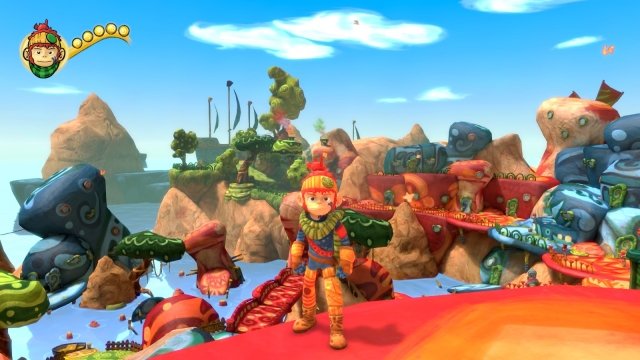
One day, Koru is tricked by a purple spirit into releasing a dangerous white sludge known as “Bleakness”, draining much of Tinkerworld’s colour. Koru, being the last Tinker, is tasked with recruiting the red, green and blue spirits to help him stop the bleakness. It won't be easy though; each of the colours represents a different emotion (red = aggressive, green = scared, blue = depressed), and the spirits will take some convincing to work together.
The game opens in the outer district on the day of a big race. Here, you’re introduced to the game’s basic mechanics of melee combat and platforming. Unlike traditional 3D platformers, navigation in The Last Tinker is mostly automated; holding down RT sees Koru hopping from one place to the next with ease - think Sly Cooper meets Assassin’s Creed. Combat starts out pretty simple too, with repeated mashing of the B button being the main strategy.
Things get slightly more interesting later when Koru gains his colour-based powers. In line with the emotions tied to each colour, the red attack hurts enemies, the green attack sends them running in fear and the blue attack stuns and causes them to cry (each colour-coordinated to the B, A, and X buttons, respectively).
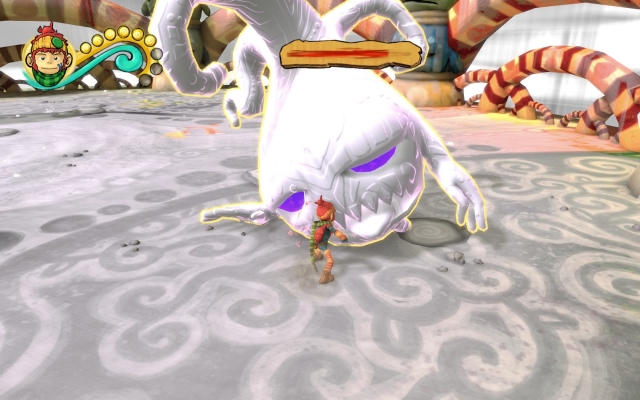
Despite the colourful attacks, combat remains a pretty simple and tedious affair throughout the game. The same goes for the platforming which, apart from a few timing-based sections, causes no real trouble. However, it is satisfying to quickly and smoothly traverse levels, even if it is automated. Most of the game's, albeit limited, challenge comes from environmental puzzles, usually involving a mushroom creature.
This fun guy comes in two sizes, the large version named Biggs, and the small version named Boomer. Using your various powers will have different effects on him: hitting Biggs with the red power will make him stomp the ground, used for hitting floor switches; using the green power causes Biggs to panic and run away with Koru on his back, destroying everything in his path; using the blue power makes him cry and drop a seed that clears the area around it of bleakness.
Boomer has his own uses. The red power will make him explode, destroying obstacles around him. With the green power you can aim him and send him running through pipes. Use blue and he'll start crying, creating explosions around him to kill enemies. With all of these abilities, there is plenty of potential for puzzles, and Mimimi Productions have done a good job of keeping this part of the game interesting, even if none of the puzzles are particularly difficult.
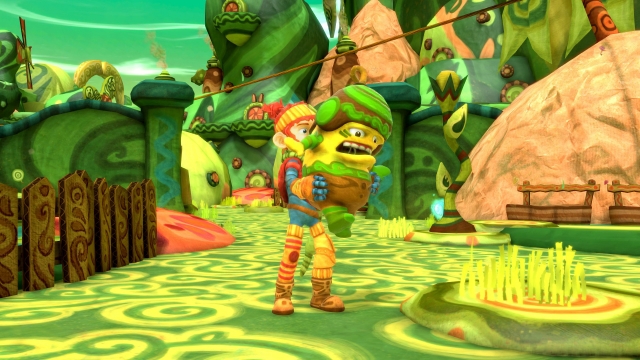
Another compelling aspect of the game is its visuals. The world is brought to life wonderfully with varied and vibrant environments. Each of the game’s areas has its own colour scheme and is complete with clever details - like the cardboard surveillance cameras that follow you in the paranoid greens’ district. The creatures themselves are also a highlight; The Last Tinker's charming characters all have a unique design that wouldn't go amiss in a Pixar or Aardman animation.
This level of quality extends to the audio. Its soundtrack is packed with excellent folksy tunes, each fitting its respective environment. One great use of the music is in a level where most of the colour has been drained by bleakness; this black-and-white area sees you investigating a crime in the district, and the noir-esque section is perfectly backed by a jazzy saxophone solo.
In the fashion of classic 3D platformers like Banjo Kazooie, the characters in The Last Tinker spout gibberish accompanied by text, rather than using voice actors. However, look past the primitive storytelling technique and you'll find a tale well worth paying attention to. For a title seemingly aimed at children, the subtext of racism is a bold choice, but it's handled extremely well. Promoting harmony and teamwork, it plays out like a parable of sorts.
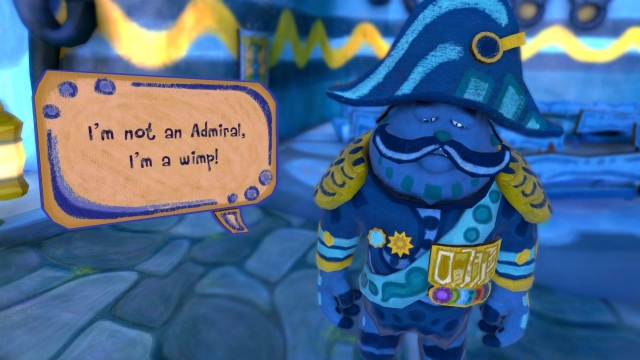
The story will take you around 7-8 hours to complete, but it’ll take another 3-4 to gather all the collectibles. These golden ‘floaty brushes’ can be used to unlock concept art and gameplay modifiers like Big Head and Mirrored World, as well as an arena mode. In spite of the game’s linear level design, some of the collectibles are devilishly hidden, but thankfully the developers have made it easy to return to past levels in order to find the brushes you missed.
The Last Tinker: City of Colors is a breath of fresh air for those fed up with the brown modern shooters we’ve become accustomed to. Aside from the occasionally tedious combat, it’s a fun and memorable experience for kids and grown-ups alike. I can only hope that other developers follow suit and continue to revive this once-loved genre.
The Last Tinker: City of Colors (Reviewed on Windows)
This game is great, with minimal or no negatives.
The Last Tinker: City of Colors is a breath of fresh air for those fed up with the brown modern shooters we’ve become accustomed to. Aside from the occasionally tedious combat, it’s a fun and memorable experience for kids and grown-ups alike.


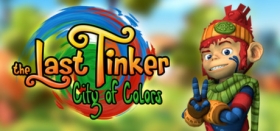






COMMENTS